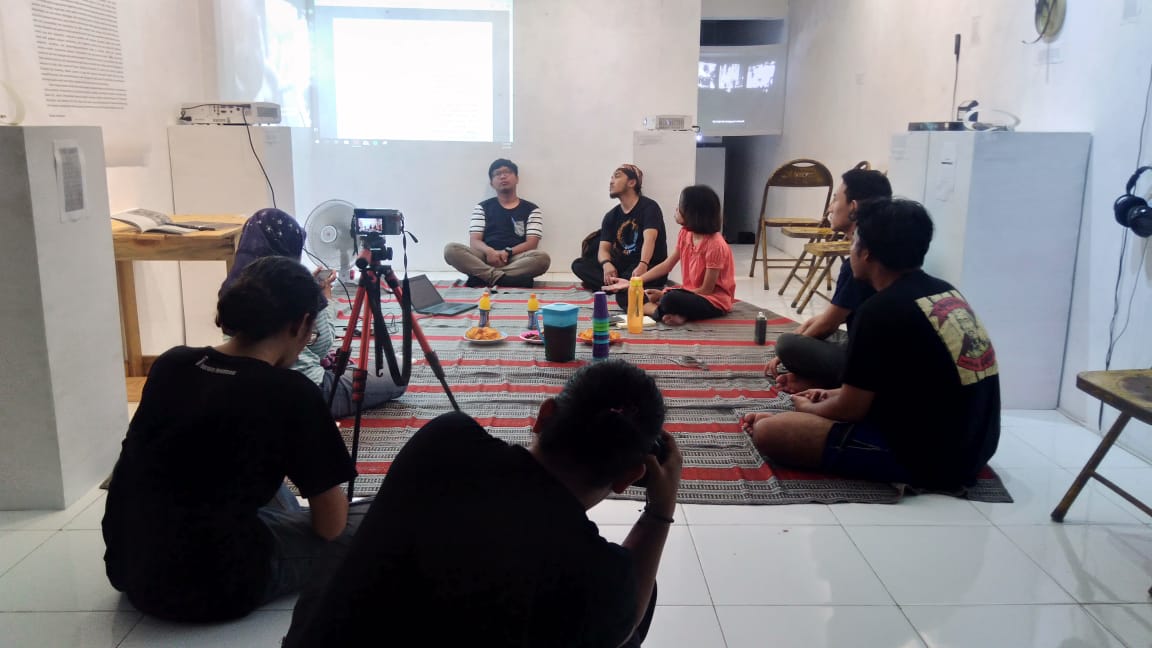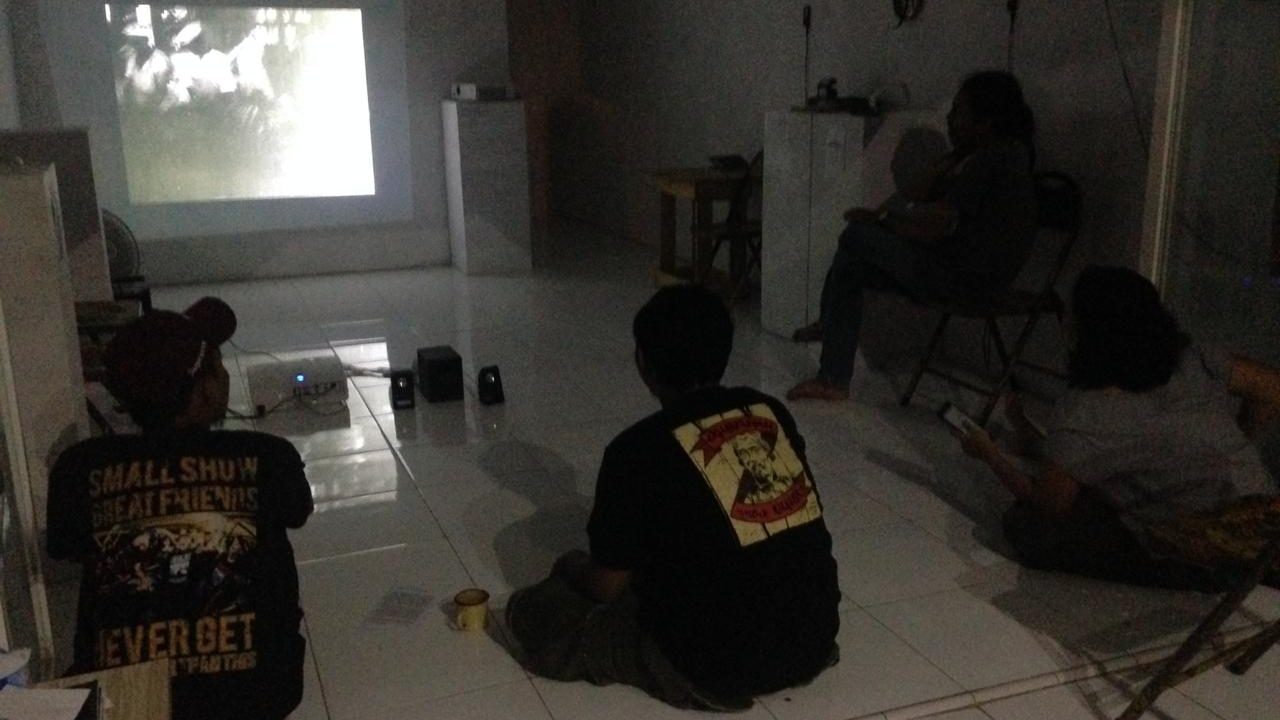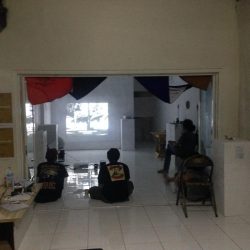The Kultursinema Travelling Exhibition 2019 ended in the city of Semarang. This last exhibition was opened with a discussion session with the theme “Screening Room and Film Archives” on May 1, 2019, at Grobak Hysteria. Several communities that actively screened films around Semarang City attended the panel as speakers, such as Erma Yuliati, a film programmer from Sineroom, Wan Fajar, film programmers from Grobak Hysteria, and Abdul Aziz Kurniawan, Eling Cinema chairman. Wahyu Budiman Dasta, one of the members of the Kultursinema Team, became the moderator in this panel. Erma Yuliati shared about the Sineroom space which shown alternative films in Semarang. Besides that, Sineroom also discussed films that were screened, and also brought together films with other mediums through exhibitions and podcasts. Abdul Aziz Kurniawan shared about Eling Cinema who likes to exhibit alternative films. Eling Cinema also makes efforts for films made by Semarang filmmakers to be played in the villages of the City of Semarang. In addition, they also held workshops for children around the village. Wan Fajar from Grobak Hysteria shared his experience in screening films in villages to activate the village. In addition to screenings in the village, there was also a screening of the film at Grobak Hysteria headquarters in the Bendan Ngisor area. The film screening at Grobak Hysteria headquarters is complemented with film discussions along with expert speakers. On the second day, May 2, 2019, two films were screened. The first film was Tie Pat Kai Kawin (Siloeman Babi Perang Siloeman Monjet) directed by The Teng Chun in 1935. The director used visual effects in this film, and not infrequently the audience was laughed at because of it. The second film that was played was Matjan Berbisik (The Whispering Tiger). The film was directed by Tan Tjoei Hock in 1940. The film has its own title in Dutch, De Fluisterende Tijger. After the screening, several spectators were seen discussing the two films. Regarding Tie Pat Kai Kawin, one of the viewers said that he was amazed at the way the director played stop-motion and scratch visual effects on his celluloid film in the 1930s. Regarding the Matjan Berbisik film, one viewer expressed his opinion about its character development that uses no dialogue in the early minutes of the film. Then, on May 3, 2019, a second-panel discussion program was held, titled “Archive Reproduction and Reproduction”. Prashasti Wilujeng Putri acted as a moderator in this panel and invited several people as speakers, such as Afrian Purnama from Kultursinema, Tries Supardi who is a video artist, and Arief Hadinata who is also a visual artist and involved in Hysteria. Afrian Purnama shared about the framework and artistic methods of Kultursinema. He also shared about the importance of archives and how bad archiving in Indonesia would be an opportunity for us to be free in interpreting the archives. Then Tries Supardi presented the project of collecting archives in Karimunjawa and later distributed to local residents as art exhibitions, books and films. This project still continues until now. The third speaker, Arief Hadinata a.k.a Hokage presented his work with Hysteria in activating residents and space in Bustaman Village, one of them was by making an archive of the myths in the village. The next day, May 4, 2019, the second film screening program was held. This time the film was Calling Australia by Hinatsu Eitaro made in 1943, Nippon Present by Jaap Speyer made in 1945, and Indonesia Calling by Joris Ivens made in 1946. Calling Australian was created by Hinatsu Eitaro aka Huyung in 1943. Huyung made the propaganda film following the order of Nippon Eigasha, an institution that specializes in producing and distributing propaganda films throughout Indonesia, both in open-air format and screenings in a theater. This film tells the condition of the European and Australian prisoner-of-war soldiers filled with luxury and happy life at Japanese camp. The film was later deconstructed to become another film called Nippon Present (a.k.a. Nippon Calls. 1945) made by Jaap Speyer from the Netherlands. Nippon Present uses the Calling Australian as the main material for the film. The film discusses scenes in Calling Australian films which were considered a lie. In the film, Jaap Speyer invited the people that acted in Calling Australia film to tell the Dutch or NICA allies version of the truth. The Nippon Present film is a film inside the film. What is also interesting is that the Calling Australian film was opened by statements both through pictures and narrators, that the film was made by Australian and European prisoners of war themselves. In the same year, a Dutch director Joris Ivens produced Indonesian Calling (1946) which he made in an Australian port. Joris Ivens who supported Indonesia’s independence in 1945 by making the film, has caused him to be expelled from the country where he was born, the Netherlands. To this day, Indonesian Calling is very important films for Indonesia. Not only is it a factual historical document, but also its aesthetic contribution to the development of cinema in Indonesia. On the last day, the Kultursinema Travelling Exhibition was finished with a discussion on “Historical writing and Archive”. M. Bayu Widagdo, a lecturer at the Department of Communication at Diponegoro University, and M. Yogi Fajri, a history blogger present as the speaker. Dini Adanurani as the moderator led the discussion about the history of films that included technological, aesthetic and social, and political history. The two speakers agreed that the historical writing of Indonesian films still leaves a large study hole, namely the history of Indonesian aesthetic films. M. Yogi Fajri himself stated about the search for history outside the academic realm, while M. Bayu Widagdo in his presentation invited viewers to explore the definition of what history is. Year Semarang, Indonesia
2019
Kultursinema Traveling Exhibition – Semarang, 2019
























